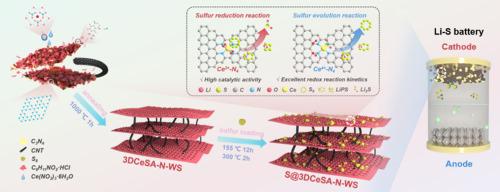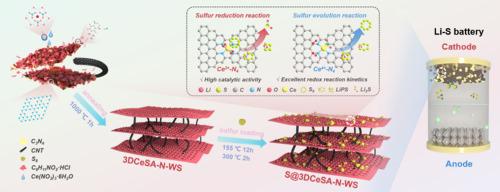稀土金属 Ce-N 配位工程作为锂硫电池高氧化还原动力学的催化剂
IF 20.2
1区 材料科学
Q1 CHEMISTRY, PHYSICAL
引用次数: 0
摘要
锂硫(Li-S)电池具有理论能量密度高、成本低和环保等优点,是储能领域的一个重要研究方向。然而,锂多硫化物(LiPSs)中间体造成的穿梭效应往往导致循环稳定性差。因此,构建合理的正极结构以实现吸附和催化 LiPSs 的快速反应动力学是获得高性能锂-S 电池的关键。金属单原子催化剂(SAC)以其 100% 的原子利用率和低成本而著称,在锂-S 电池的氧化还原反应中表现出卓越的催化活性和选择性,使其成为该领域最有前途的催化剂之一。稀土金属 SAC 具有多种氧化态、多种配位化学性质和环境友好性,但在锂-S 体系中却很少被研究。在此,我们制备了一种支撑在三维多孔 N 掺杂碳(3DCeSA-N-WS)上的稀土金属基单原子催化剂(CeSAs),并对其在锂-S 电池中的性能进行了系统研究。3DCeSA-N-WS 具有原子分散性和多种氧化态(Ce3+/Ce4+),因此在锚定和催化锂离子电池方面表现出色,显著提高了氧化还原反应的动力学性能。因此,所制备的硫阴极表现出卓越的电化学性能,在 0.2 C 条件下的初始比放电容量高达 1225 mAh g-1,160 次循环后的容量保持率为 76.1%。这项工作为硫阴极催化剂的设计提供了新的见解,从而有助于实现高性能锂-S 电池。本文章由计算机程序翻译,如有差异,请以英文原文为准。


Engineering rare earth metal Ce-N coordination as catalyst for high redox kinetics in lithium-sulfur batteries
Lithium-sulfur (Li-S) batteries are a key area of research in energy storage due to their high theoretical energy density, low cost, and environmental friendliness. However, the shuttle effect caused by lithium polysulfides (LiPSs) intermediates often results in poor cycling stability. Therefore, constructing rational cathode structures to achieve fast reaction kinetics in adsorbing and catalyzing LiPSs is the key to obtain high-performance Li-S batteries. Metallic single-atom catalysts (SACs), known for their 100 % atomic utilization rate and low cost, have demonstrated excellent catalytic activity and selectivity in the redox reactions of Li-S batteries, positioning them as one of the most promising catalysts in this field. Rare earth metallic SACs with versatile oxidation states, diverse coordination chemistry and environmentally friendly are rarely investigated in Li-S system. Herein, we fabricate a rare earth metal-based single-atom catalyst (CeSAs) supported on a three-dimensional porous N-doped carbon (3DCeSA-N-WS), and systematically study its performance in Li-S batteries. Benefitting from the atomic dispersion and versatile oxidation states (Ce3+/Ce4+), the 3DCeSA-N-WS demonstrates excellent performance in anchoring and catalyzing LiPSs, significantly enhancing the redox reaction kinetics. Consequently, the prepared sulfur cathode exhibits exceptional electrochemical performance, with a high initial specific discharge capacity of 1225 mAh g−1 at 0.2 C and a capacity retention of 76.1 % after 160 cycles. The assembled 100 mAh-level pouch cellmaintains a high specific discharge capacity of 877 mAh g−1 after 50 cycles at 0.5 C. This work provides new insights into the design of sulfur cathode catalysts, thereby contributing to the realization of high-performance Li-S batteries.
求助全文
通过发布文献求助,成功后即可免费获取论文全文。
去求助
来源期刊

Energy Storage Materials
Materials Science-General Materials Science
CiteScore
33.00
自引率
5.90%
发文量
652
审稿时长
27 days
期刊介绍:
Energy Storage Materials is a global interdisciplinary journal dedicated to sharing scientific and technological advancements in materials and devices for advanced energy storage and related energy conversion, such as in metal-O2 batteries. The journal features comprehensive research articles, including full papers and short communications, as well as authoritative feature articles and reviews by leading experts in the field.
Energy Storage Materials covers a wide range of topics, including the synthesis, fabrication, structure, properties, performance, and technological applications of energy storage materials. Additionally, the journal explores strategies, policies, and developments in the field of energy storage materials and devices for sustainable energy.
Published papers are selected based on their scientific and technological significance, their ability to provide valuable new knowledge, and their relevance to the international research community.
 求助内容:
求助内容: 应助结果提醒方式:
应助结果提醒方式:


